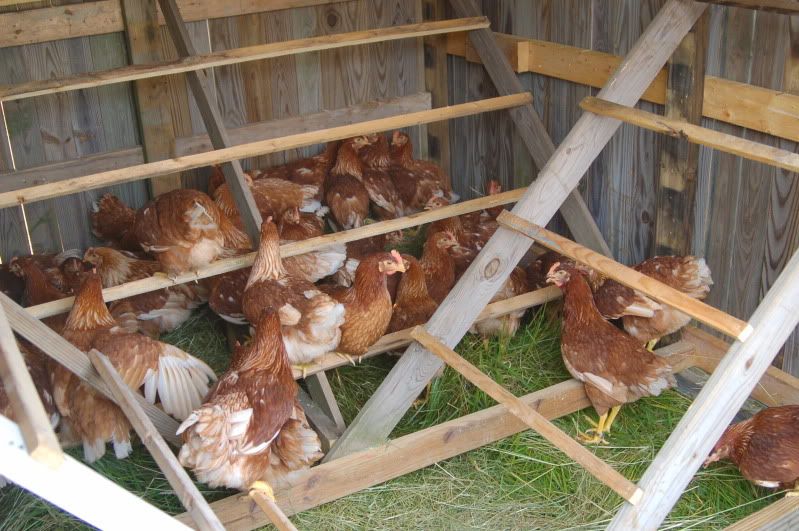About a month ago, we brought 41 new hens to the farm. It was crazy. We felt crazy. We were told we're crazy. There was a lot of clucking going on and it wasn't all in the field. But that's okay because we welcome opinions and input and ideas. We don't have all the answers, just the determination to try something a bit left of center. I'll freely admit that the majority of the crazy around here comes from me, but Greg can get crazy too.
So, back to the chicken crazy part.
We brought home 41 hens. We already had a dozen Rhode Island Reds (including two roosters) as well as about 7 or 8 Ameracaunas (which included 3 - yes, 3 - roosters). The idea was to take the coop raised RIRs, the "I own this farm and will go wherever I want" Ameracaunas and all the new hens and throw them all into the pasture with a new roosting house and a new nesting house. Everyone would free range, a new pecking order would be established, all our eggs would be produced from hens happily scavenging for bugs and grass and seeds and weeds the way happy chickens do. It would be a Norman Rockwell, picture perfect, slice of apple pie, American farming dream come true.
Ha!
 |
| They didn't know how to roost |
That first night was, well, horrible. The Ameracaunas all went through the electric fence and made their way back to their coop either during the night or during the next day. The new hens had no idea what roosting was so they all clucked around and slept on the grass in the roosting house and wouldn't come out until I physically picked them up and shoo'd them out the next afternoon. By that time, they hadn't had food or water for 24 hours. And the RIRs. Oh the poor RIRs. Let's give them their very own paragraph.
 |
| Greg's Rhode Island Reds |
Greg's Rhode Island Reds have been in the coop for most of their lives. For a while, they free ranged. Until a kindly neighbor in the subdivision that borders the farm started feeding them seeds and one day forgot that they had fed the chickens and let their dog out who killed on of the birds and Animal Control was called. Since then, Greg has kept the RIRs in the coop. They have been in there for a year, happily eating and clucking and producing eggs. They have a very strong sense of where their coop is. So when we tossed them into an open air roosting house, we had no way to keep them in there to help them redefine their sense of home. Consequently, they tried to get home that night. They wanted the safety of their coop and the security of roosting in the same place they had roosted for the past year. We didn't think about that. If we had, we would have hopefully been smart enough to leave the coop door open so they could get back in. We didn't. One rooster was eaten. The other rooster was caught in the deer fencing for the garden right next to the coop. He was severely traumatized although not very injured. It took several weeks before he would crow again. Some eventually found their way back to the coop, although one hen decided to stay in the pasture with the new hens. Sadly, about half the RIR hens were eaten. Greg now has one rooster who, when crowing, sounds like he has a frog in his throat or is a 13 year old boy going through puberty. It's pitiful. And a little funny. But mostly pitiful.
We learned quite a few lessons that night and the next day.
About two weeks later, a fox or coyote attacked the flock and killed about 20 chickens. We had been doing a lot of other things on the farm and didn't realize what had happened until late afternoon. I went out to check on them and realized the flock looked very sparse. I thought maybe a bunch of the hens were hanging out in the nesting house since it was so hot outside and the nesting house is dark and cool. But as I walked through the pasture, I kept coming across piles of feathers. Each time I saw a pile of feathers, my stomach tightened a little bit more. When I came across the first dead chicken, my fears were confirmed. The more I walked the pasture, the more dead chickens I found. We did a count and came up with 21 chickens and 1 rooster. Half the flock was gone.
Five days later, we were hit again. Ten more hens were dead or missing. We're down to 11 hens and my white Ameracauna rooster who claimed the flock.
The hens have stopped using the roosting house and are roosting on the nesting boxes. It's a mess. Greg is going to make shutters so we can close the chickens up at night for their safety and to keep them from roosting in the nesting house. We plan to replace the electric wire with electric poultry netting as soon as we can afford it.
We're going to try to buy more layers as we can and continue to produce eggs. We've learned some tough lessons and made some costly mistakes.
And we're still crazy enough to keep at it until we can make it work.


No comments:
Post a Comment